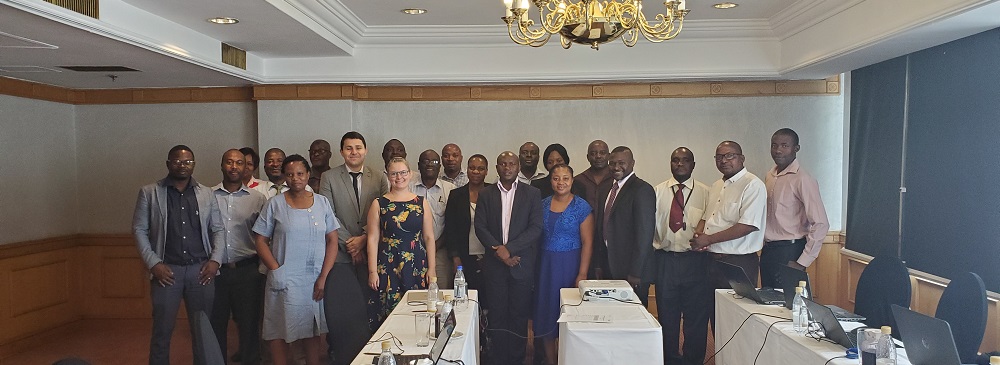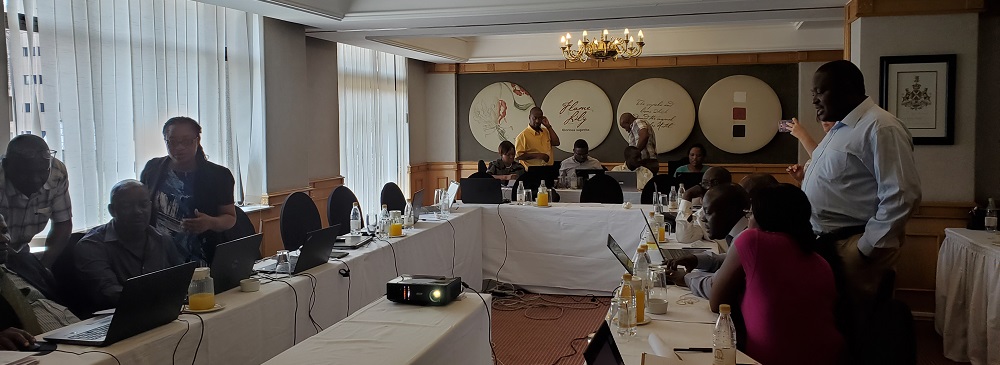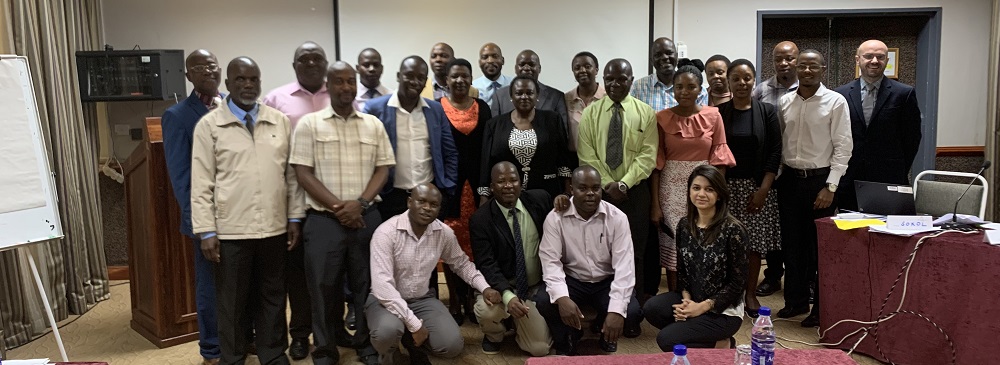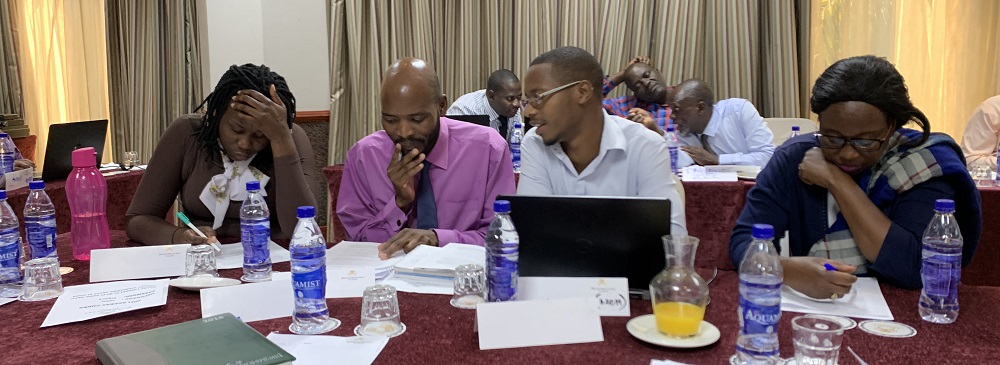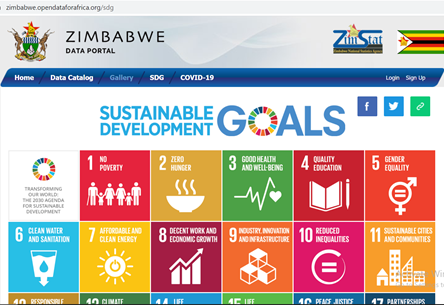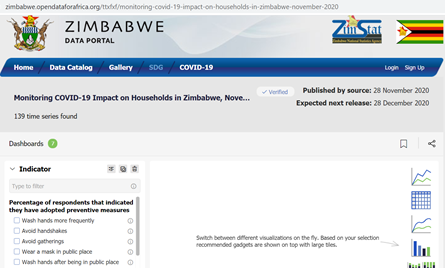Zimbabwe
I. General on SDG monitoring set up
National SDG organizational set up
The overall SDG process is overseen by the Office of the President and Cabinet (OPC). The work is implemented jointly by agencies and ministries who are involved in SDG monitoring, with the Ministry of Public Service, Labor and Social Welfare (MPSLSW) having an overall coordination responsible. The work on goal implementation has been split into three different thematic groups which have been given responsibility for a certain amount of goals. They are led by MPSLSW, the Ministry of Health and Child Care and Ministry of Lands, Agriculture, Water and Rural Resettlement.
National set of SDG indicators
In 2018, UNSD worked with ZIMSTAT on assessing the capacity of the Zimbabwean statistical system of reporting on the globally agreed indicators. The assessment identified 28 indicators to be currently available and additional 57 indicators to be easily feasible to obtain. Whether all of them will be collected and disseminated will depend on the final set of the national indicator framework.
One of the tasks the agencies have been working on is to agree on and prioritize a localized set of SDG indicators. In this process, the agencies used two guiding principles; i) alignment with the Transitional Stabilization Plan with its M&E framework and ii) availability of data to measure progress on the goals. The work is now in its final stages and will soon be made available.
For the second process, ministries identified goals they could provide data for and reported back on availability. The process gave insight and learning as many did not know how to extract information in the required format. This was particularly linked to usage of administrative data and there is agreement that there is a need to gain more experience on how to extract information from registers which helps inform the SDG agenda. As a response to this, the MPSLSW organized practical workshops on how to populate the indicators.
In total, the national indicator framework consists of 205 indicators. Of these, 205 are corresponding to the globally defined indicators.
SDG reports and Voluntary National Reviews
Zimbabwe is currently working on its annual SDG Progress Report. The report will provide content for Zimbabwe’s second Voluntary National Review which will be presented at the High-Level Political Forum in New York in July 2020.
Zimbabwe has chosen to use the Open Data Portal provided by the African Development Bank.
Overall coordination of National Statistical System
The NSS brings together producers, suppliers and users of statistics with ZIMSTAT playing a coordinating role. These are drawn from Government, Tertiary Institutions, Development Partners, Civil Society, Private sector and Parastatals. The NSDS provides a comprehensive framework to guide the strengthening of the NSS through well-coordinated administrative data systems, surveys and censuses to address data needs for national programmes, SDG monitoring, regional and global initiatives.
SDG data coordination committees
Within the NSS, there are cluster groups focusing on various thematic areas. One of their functions include identifying data gaps within their domain and recommending or taking measures to close these gaps. SDG monitoring is spread across all thematic groups.
Responsibility for SDG indicator compilation
Each participating Ministry/Agency focuses on specific indicators depending on its line of work, e.g. Ministry of Health is expected to play a leading role in the provision of data for monitoring health related SDG indicators, etc. Currently data sharing needs to be strengthened to allow ZIMSTAT to play its coordinating role within the NSS effectively.
The Statistics Act empowers ZIMSTAT to collect data from individuals and entities through surveys and administrative sources. However, there are currently no formalized arrangements for data collected from administrative sources making it difficult to get the data on time. Plans are underway to have data sharing agreements with all institutions that supply administrative data and a data sharing template is in place ready for testing in 2021. The arrangements should make it possible for ZIMSTAT to collect data to fill some of the gaps in SDG indicator monitoring.
A Data for Development Group (DFD) was established many years ago. The DFD Working group comprise representatives of ZIMSTAT directorate, Government Ministries, UN Agencies, International Financial Institutions (IFIs), bilateral and multi-lateral donors, private sector, academic institutions and relevant civil society organisations. The Working Group is co-chaired by ZIMSTAT and UNFPA. The working group meets twice a year or as and when a meeting is needed. The working group is a subgroup of ZUNDAF. In recent years it has mainly focused on data exchange related to the SDGs although it is not formally a part of the SDG cluster system. The group has agreed on an excel template for SDG indicator reporting from responsible agencies to ZIMSTAT and some agencies are already providing information.
In October 2019 a workshop was conducted with support from UNSD for all focal points. They agreed on a monitoring and evaluation template which is in its final stages of development.
The SDGs are also specifically mentioned in the current National Strategy of Development of Statistics - NSDS II for the years 2016-2020. A thorough mapping of the SDGs to the prior development plan was made which can be seen in the annex of the Strategy.
Actual data sharing mechanisms
Currently there are not many agencies who share their SDG data with ZIMSTAT. Some agencies are sharing data generally, this includes the Ministry of Health. Collaboration is also working well because ZIMSTAT regularly seconds statisticians to the ministry to support statistical work. A formal agreement on data sharing is in place with the Zimbabwean Revenue Authority.
UNSD presented various options for data sharing with ZIMSTAT and representatives of the wider statistical system in October 2019. The proposed way forward is to develop a joint agreement under the Data for Development Group on sharing SDG indicators. It was further suggested that the agreement, or exchange of letters, should specify which indicators or variables each agency is expected to share, disaggregation dimensions, periodicity of sharing and means of sharing.
The District Health Information System (DHIS2) is seen as a potentially useful source for data on SDG 3. Processed data are also expected to be received from Ministry of Education and Ministry of Energy to some extent. For other agencies, more work and support in processing the data, including data quality assessments and improvements, will be needed.
The Country/NSS has an open data approach as evidenced by the drive to promote use of microdata and provision of metadata. These are areas still being developed but the goal is to make data available to users through online platforms such as the Zimbabwe open Data Portal.
IV. Data availability and disaggregation
Work to make more indicators available
The Statistical Office held an interactive meeting with producers, suppliers and users of statistics before the lockdown restrictions to highlight some of the areas where huge data gaps exist and the need for close cooperation with data suppliers to close these gaps. New modules have also been introduced in some household-based surveys to improve indicator availability.
ZIMSTAT mainly provides data for indicators through census and surveys. Many of these are disaggregated by gender and geographical area.
Work to allow more disaggregation
There is promotion of data disaggregation in censuses and surveys. The next NSDS-III, still to be developed will also put strong emphasis on the disaggregation of data.
ZIMSTAT plans to engage a Consultant to assist with the development of a metadata handbook to be used by all departments to produce metadata. We expect this process to commence in early 2021.
Zimbabwe has officially adopted its first User Engagement Strategy as part of the UNSD-FCDO project.
Implementation plan and activities
ZIMSTAT has started implementation of agreed upon user engagement activities. This includes various advocacy campaigns, for instance presence at an international trade fair and Zimbabwe agriculture shows. ZIMSTAT is also currently in the process of updating and improving its webpage.
ZIMSTAT celebrates Africa Statistics day annually. They also conduct breakfast meetings where specific topics of interest are covered.
To learn more from users, user-producer symposiums are conducted every 5 years. In these symposiums they get an update from various users and listen to the users’ expectations and additional needs from ZIMSTAT. Who participates is selected from a list which all the different ZIMSTAT divisions maintain: It is usually a mix of different user groups, including non-Governmental actors. ZIMSTAT also runs consultative workshops when launching a survey.
VII. National Response to COVID -19
Responding to the need for information on Covid-19, ZIMSTAT together with the World Bank and UNICEF, designed a high-frequency telephone survey of households to measure the socio-economic impacts of COVID-19 in Zimbabwe. The survey builds on the Poverty, Income, Consumption and Expenditure Surveys (PICES) of 2017 and 2019 and uses a sample that is nationally representative. The report for the first round of survey is available here.
The report summarizes the results of the first round of the Rapid PICES, conducted between 6th and 24th July, 2020. The telephone interview lasted for 25 minutes on average and covered topics such as knowledge of COVID and mitigation measures, access to and participation in educational activities during school closures, access to basic necessities, employment dynamics, income losses, food security and assistance received. The plan is to repeat the interviews every 4-6 weeks.
